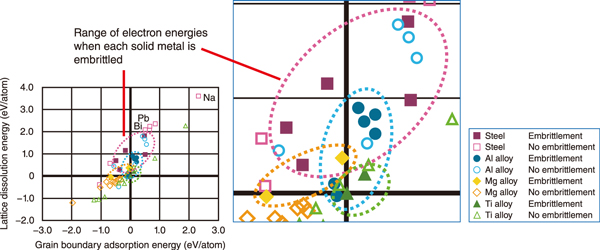
Fig.1 Relationship between the energy of liquid metal atoms entering a solid metal and the element selectivity (embrittlement/non-embrittlement)

Fig.2 Schematic of the embrittlement criterion based on “atomistic weak interaction”
Metallic materials are susceptible to cracking when exposed to liquid metal. For example, embrittlement often occurs when high-strength steel materials come in contact with a liquid Pb-Bi mixture used as a coolant in an accelerator-driven subcritical reactor. Such embrittlement occurs depending on the temperature and other conditions, and clarification of the embrittling mechanism is necessary to prevent cracking. Interestingly, almost no embrittlement occurs in some cases. For example, steel materials are less embrittled when exposed to liquid Na when compared to Pb or Bi (Fig.1). This phenomenon of differences in embrittlement depending on the liquid-solid metal combination is called “element selectivity (specificity) of liquid metal embrittlement.” However, the cause of this specificity remains unclear; understanding this may help us understand its mechanism.
Therefore, using first-principles calculations, a computational science method that accurately calculates the electronic structure of materials, we compared the experimental and computational results for approximately 50 liquid-solid metal combinations to investigate the cause of element selectivity (Fig.1). We found that embrittlement tends to occur when the energy representing the interaction of the liquid metal atoms in the solid metal lattice (lattice dissolution) or at the grain boundary (grain boundary adsorption) is not large−neither large positive values (strong repulsion) nor large negative values (strong attraction). In other words, embrittlement is likely to occur when the atomistic interactions are weak.
The mechanism of embrittlement inferred from this “atomistic weak interaction” criterion is shown in Fig.2. The driving force of cracking is considered to be a reduction in the surface energy of the solid metal due to the liquid metal atom adsorptions. However, for this surface adsorption-induced cracking, the liquid metal atoms must penetrate the crack tip of the solid metal−as a precursor phenomenon−and should not adhere too strongly. This mechanism agrees with the relationship shown in Fig.1, but further studies are necessary to clarify the details.
This research was partly supported by MEXT as exploratory challenge on Post-K computer “Challenge of Basic Science - Exploring Extremes Through Multi-Physics and Multi-Scale Simulations.”
(Masatake Yamaguchi)